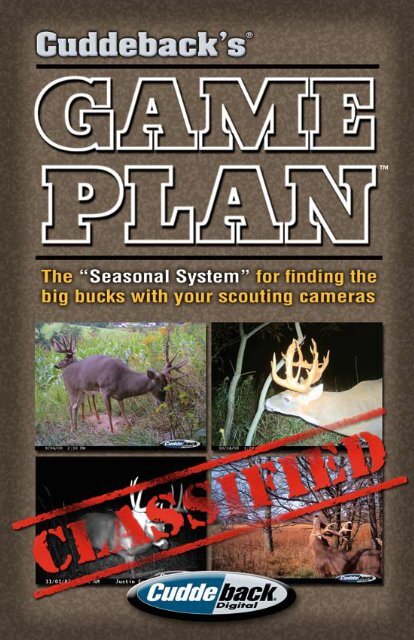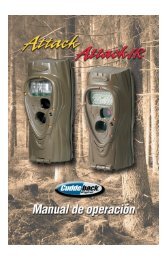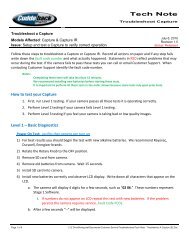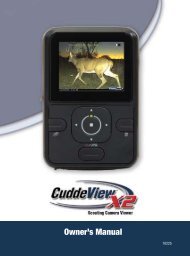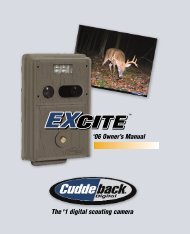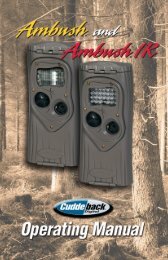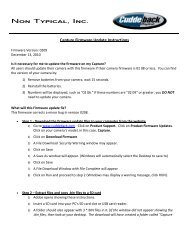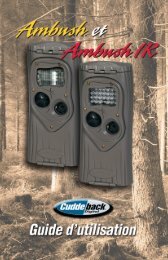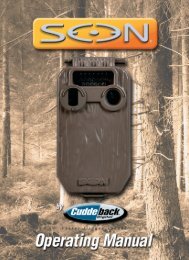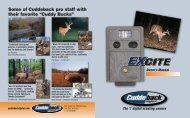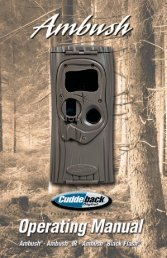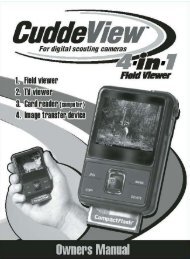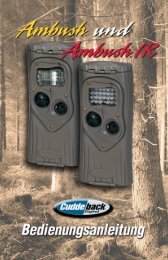Create successful ePaper yourself
Turn your PDF publications into a flip-book with our unique Google optimized e-Paper software.
GAME PLAN<br />
<strong>Game</strong> <strong>Plan</strong> is the revolutionary new “seasonal system” for<br />
finding big bucks with your scouting camera. Developed by <strong>Cuddeback</strong>,<br />
the #1 name in digital scouting cameras, <strong>Game</strong> <strong>Plan</strong> is a guide for<br />
when and where to place your cameras to maximize the chances of<br />
finding that buck of a lifetime.<br />
The <strong>Game</strong> <strong>Plan</strong> system breaks down the year into nine seasons.<br />
Each season is decidedly different in terms of where you deploy<br />
your scouting cameras and what you can hope to accomplish.<br />
Follow <strong>Game</strong> <strong>Plan</strong> and you will have a better idea of what bucks<br />
are on your property and how to best set up to harvest the biggest<br />
one around.<br />
The Nine Seasons<br />
When we say seasons, we are not referring to spring, summer,<br />
fall and winter. The <strong>Game</strong> <strong>Plan</strong> seasons are “phenological.” They<br />
follow the various seasons in the annual life of the whitetail deer.<br />
This way, they apply equally as well north or south, although not<br />
necessarily at the same time on the calendar. If you are an<br />
experienced hunter, you will recognize these “seasons.” What<br />
we’ve done is to identify how to best use scouting cameras during<br />
each one.<br />
Most scouting camera users, even those who are experienced<br />
hunters, tend to put cameras on food plots, trails, scrapes or<br />
stand sites and leave them there throughout the hunting season. In<br />
some cases, they have learned that certain spots experience more<br />
activity early or late and will move their cameras accordingly.<br />
That’s what <strong>Game</strong> <strong>Plan</strong> is really all about. We’ve fine tuned this<br />
approach and developed a system for you to follow. <strong>Game</strong> <strong>Plan</strong><br />
gives you the formula to become successful at scouting deer with<br />
your cameras.
1. Summer<br />
pg 1<br />
Inventory every buck on your property by putting your<br />
cameras in funnel areas on primary food sources<br />
2. Pre-Opener<br />
pg 7<br />
Pick out a buck to hunt for opening day and use your<br />
cameras to determine his pattern<br />
3. Opening Day<br />
pg 11<br />
Set up to catch your buck still sticking to his summer<br />
patterns on opening day and the days following<br />
4. The Lull<br />
Use your cameras to find deer activity during that<br />
period prior to the rut when deer seem to lay low<br />
5. Pre-Rut<br />
Take advantage of a buck’s early rutting activity<br />
by monitoring rub lines and primary scrapes<br />
6. The Rut<br />
Once the rut is in full force you are better off<br />
finding bucks by looking for does<br />
pg 13<br />
pg 17<br />
pg 21<br />
7. Post Rut<br />
Once the rut is over, concentrate your scouting<br />
efforts on food sources as big bucks need to eat<br />
to prepare for winter<br />
8. Post Season<br />
The best time to start scouting for next year’s trophy<br />
is the day this year’s season ends<br />
9. Springtime<br />
pg 25<br />
pg 27<br />
pg 29<br />
Don’t put the cameras away just because the bucks<br />
have lost their antlers (Plus bonus section on scouting bears,<br />
scouting turkeys and general tips)
1<br />
SEASON 1<br />
Summer<br />
Goal: Inventory all bucks<br />
on your property
Wouldn’t you love to have an image of each and every buck<br />
on your property Seeing all of them would be extremely<br />
helpful when it comes to determining which bucks to hunt and<br />
which ones to let grow. Before a particular buck walks through<br />
your shooting lane, you would be able to determine if he is the<br />
animal you want to take, or if you should wait for a bigger buck.<br />
The very best time to inventory bucks is during the summer<br />
months. Does are looking after their fawns during summer and<br />
generally have little interaction with bucks. The deer world is<br />
matriarchal which means that the does run the show. So bucks are<br />
relegated to their own small groups called bachelor groups. Bucks<br />
tend to hang out during the summer in bachelor groups of similar<br />
age, so not all of the bucks<br />
on your property are likely<br />
to be together. Bucks also<br />
tend to lay low during this<br />
time of the year choosing to<br />
stay in cover during the heat<br />
of the day while traveling<br />
short distances to feed<br />
during low light hours and<br />
at night.<br />
If you think about it,<br />
how often do you see bucks<br />
A typical “bachelor group” of bucks feeding<br />
during the summer season<br />
roaming around or crossing roads during the summer Relatively<br />
speaking, not very often.<br />
The fact that bucks congregate during the summer months<br />
and that their movement is predictable and related to food, gives<br />
the scouting camera user an opportunity to pinpoint likely areas of<br />
frequent travel.<br />
Look for primary food sources<br />
First, you need to find the primary summer food sources.<br />
This is easy if you have food plots or agricultural sources that draw<br />
the animals. If you don’t have access to food plots or agriculture,<br />
search for the best primary food sources you have.<br />
2
Locate funnel areas or sweet spots within food sources<br />
Once you identify as many of these primary food sources as<br />
you can, thoroughly scout them looking for travel funnels or sweet<br />
spots within each food source. Do not scout travel funnels going<br />
to or from the food source,<br />
but travel funnels within<br />
the actual feeding areas.<br />
Deer will move through a<br />
food source while they are<br />
feeding. Eventually, most,<br />
and perhaps all deer, will<br />
have spent at least some<br />
time just about everywhere<br />
in the food source. However,<br />
there are certain areas<br />
within each food source that<br />
The best place to get images of deer during<br />
summer is in a funnel within a food source.<br />
get more traffic. If your food source has a natural funnel, it is very<br />
likely that every deer will eventually travel through this funnel.<br />
The funnel may be a narrowing in a food plot, a road or trail<br />
connecting food plots (see diagram 1), or perhaps some brush<br />
or rocks that force deer into a narrow area. Sweet spots include<br />
low areas in a field that retain moisture or allow deer to feed out<br />
of sight, a shady corner in a food plot or the side of a field that is<br />
closest to heavy cover. After you have pinpointed these funnels,<br />
or sweet spots, set up a<br />
<strong>Cuddeback</strong> to capture<br />
deer moving through. It is<br />
possible that within eight<br />
weeks or so you will have<br />
photographed every deer on<br />
your property.<br />
Funnel areas are superior<br />
to food source edges<br />
Many scouting<br />
camera users will simply<br />
place a camera on the edge<br />
3<br />
Deer have favorite spots within primary food<br />
sources. Find such a “sweet spot” and you’ll<br />
likely get images of every buck on the property.
of the food source. The problem with this method is that deer will<br />
frequently be too far from the camera to be seen in the image.<br />
<strong>Cuddeback</strong>’s long flash range will help in this situation, but a<br />
better solution is to place your <strong>Cuddeback</strong> such that deer will be<br />
moving within 20 feet of the camera. This will provide close up<br />
images that will make it easier to determine antler size. Finally,<br />
another advantage of setting your <strong>Cuddeback</strong> on a funnel or sweet<br />
spot is that you need only one camera per food source. In fact, that<br />
is how Mark <strong>Cuddeback</strong><br />
discovered this scouting<br />
method. On a pair of food<br />
plots, Mark set up three<br />
cameras – one on the edge<br />
of each food plot, and one<br />
on a tractor trail connecting<br />
the two plots. After three<br />
months, Mark discovered<br />
that the camera on the<br />
tractor trail captured all of<br />
the deer seen on the other<br />
two cameras, but the two<br />
cameras on the edge of<br />
the food plots did not capture<br />
all of the deer photographed<br />
on the trail. The one camera<br />
on the tractor trail was all he<br />
needed to see all the deer that<br />
visited these two plots.<br />
Placing your camera on the edge of a food<br />
plot makes it difficult to get the deer close<br />
enough to get a good look at antlers.<br />
Diagram #1<br />
Avoid moving cameras<br />
between food sources<br />
Set up cameras in as<br />
many food sources as you<br />
have on the property. If you<br />
A trail between food plots is one ideal<br />
example of a funnel that will result in<br />
photos of virtually every deer.<br />
have five food plots, you should setup five cameras. Your goal is to<br />
create an image inventory of all the bucks on your property, which<br />
requires you to monitor the entire property for the entire summer.<br />
4
Do not move<br />
cameras from plot to plot.<br />
You may discover that<br />
the bucks move from time<br />
to time, frequenting one<br />
plot for a few weeks, and<br />
then move to another as<br />
conditions change. If you try<br />
to monitor all your plots<br />
with just a few cameras,<br />
you risk missing some bucks.<br />
Be patient. Once you have found a funnel<br />
area in a food plot that produces, leave<br />
your camera there.<br />
Add a mineral block to lure wary bucks and to get better photos<br />
Another technique you can use to help assure bucks<br />
move in front of your <strong>Cuddeback</strong> is to use a mineral block as an<br />
attractant. This will increase the likelihood of getting images of<br />
every buck that visits each primary food source, even the wariest<br />
big buck. A mineral block will also help you to position the bucks<br />
for an optimal view of their antlers. Position mineral blocks<br />
roughly 10 feet from your cameras. This will give you close up<br />
images of each deer.<br />
5<br />
Use the same spots each year<br />
Once you’ve gone<br />
through the process of<br />
determining food source<br />
sweet spots, you’ll probably<br />
not have to do it again.<br />
These spots tend to be<br />
consistent from year to<br />
year and really only change<br />
with dramatic changes to<br />
the area. By using the same<br />
spots from year to year,<br />
To assure every buck gets his picture<br />
taken, place a mineral block in front<br />
of each camera.<br />
you’ll also be able to more accurately assess the relative quality of<br />
each year’s buck crop.
It’s exciting to see what<br />
bucks you’ll hunt<br />
Following these<br />
simple techniques will not<br />
only generate a complete<br />
image inventory of your<br />
deer herd, but will likely<br />
get you very excited about<br />
the upcoming hunting season.<br />
By late summer you will<br />
know what your bucks look<br />
like, and where they are.<br />
You’ll also know the makeup<br />
of your entire buck population.<br />
This process, which may<br />
sound difficult, is actually<br />
very simple and easy to set<br />
up and manage. Now we<br />
need to concentrate on getting<br />
you positioned to harvest one<br />
of these bucks.<br />
Once you’ve found a good summer spot<br />
for your camera, chances are it will be<br />
good every year.<br />
By late summer, you will have a complete<br />
visual inventory of virtually every buck on<br />
your property.<br />
Camera recommendations for Summer<br />
• Begin process in late June or early July<br />
• Use 1 GB or 2 GB media card because you will get many images<br />
• Long battery life is essential due to large number of images and<br />
long periods of time you will leave cameras out<br />
• Try to locate cameras close to mineral block or deer for close-up<br />
images so that you can better assess antlers<br />
• 3 to 5 minute delay – don’t need an image every 30 seconds<br />
• Flash camera (not infrared) is preferred for better nighttime<br />
picture quality so antlers are easier to see<br />
• Check cameras no more than once a week (or less)<br />
6
7<br />
SEASON 2<br />
Pre-Opener<br />
Goal: Pick and pattern a specific buck<br />
to hunt on opening day
In many states, the bow<br />
hunting season begins<br />
early enough that the deer<br />
are still in their summer<br />
pattern on opening day.<br />
The bucks you’ve been<br />
photographing will still<br />
be using the same food<br />
sources. To take advantage<br />
of this situation, the <strong>Game</strong><br />
Now its time to pick a buck to hunt. If you<br />
<strong>Plan</strong> is to use the images are lucky, you will have several options.<br />
from your summer buck<br />
inventory to select a specific buck to hunt and re-deploy your<br />
cameras to pattern that buck’s movements.<br />
Which buck The biggest or the most vulnerable<br />
After you’ve had<br />
the opportunity to view<br />
images of the bucks you’ve<br />
photographed during the<br />
summer, hopefully you’ll<br />
have several candidates to<br />
pick from. Obviously,<br />
antler size and makeup<br />
will be key factors in<br />
determining which buck<br />
you will target. You might<br />
also consider the vulnerability<br />
or predictability of the<br />
Try to find travel routes leading to food<br />
sources that have plenty of cover so deer<br />
move during daylight hours.<br />
various bucks. Usually the biggest buck is not the most vulnerable.<br />
They don’t get big by being predictable.<br />
Move your cameras to suspected travel routes<br />
Once you’ve determined which buck to hunt, it is time to<br />
determine where best to set up for that buck. Because that buck<br />
will likely continue to use the primary food source for a time yet,<br />
8
you’ll have the opportunity<br />
to find his travel route and<br />
catch him coming to that<br />
food source. This usually<br />
means an evening hunt and<br />
it usually means having to<br />
move to the outside edges of<br />
the food source or even into<br />
the cover along a travel route<br />
to get a shot opportunity<br />
before dark. This is where<br />
your cameras come into play.<br />
Deploy them along all travel<br />
routes to the food source to<br />
determine how the buck you<br />
To pattern your buck, put cameras on all<br />
suspected entry points to the food source.<br />
You may need to move away from the food<br />
source in order to get movement during<br />
shooting hours<br />
have chosen gets there and when. Once you’ve set up <strong>Cuddeback</strong>s,<br />
leave the area undisturbed for as long as possible. Do not check the<br />
cameras until just before opening day. Immediately before opening<br />
day (we recommend the day before if possible), check your cameras<br />
and view the images. Using these images to guide you, determine<br />
the best hunting location to ambush your chosen buck. Then set up<br />
your stand to maximize your chance of success. When placing your<br />
stand, consider how you will move to and from your stand. Your<br />
goal is to enter and leave without spooking or alerting any deer.<br />
Leave the area as undisturbed as possible, and don’t return until you<br />
are ready to hunt on opening day.<br />
Camera recommendations for Pre-Opener<br />
• Begin this process roughly two weeks before opening day<br />
• Start with fresh batteries<br />
• On field edges, or in food plots, use infrared cameras and 3 to 5<br />
minute delays.<br />
• On trails leading to food sources, use flash cameras and the<br />
shortest possible delays.<br />
• Do not check the cameras until just before opening day<br />
9
SEASON 3<br />
Opening Day<br />
Goal: Catch a big buck off guard<br />
Your cameras have been set up to pattern your big buck<br />
for an opening day ambush. It is your hope that he continues<br />
to use the same food source and that your cameras have identified<br />
his travel path to that food source. Now it is time to hunt the stand<br />
you set up during the pre-opener season. It is key that you do not<br />
make any mistakes. Many of us are a little rusty on opening day.<br />
Even the most experienced hunters tend to make opening day<br />
blunders – too much noise, human scent, and countless other<br />
11
mistakes that lead to blown opportunities. Don’t make any<br />
mistakes and, if your buck cooperates, you could very well be<br />
successful within a few days.<br />
It pays to be<br />
persistent for the first<br />
two weeks of the season.<br />
The biggest mistake most<br />
hunters will make at this<br />
point is to move from spot<br />
to spot, stand to stand,<br />
or buck to buck. Your<br />
cameras, in the weeks just<br />
prior to opening day, will<br />
have given you an idea of<br />
how often and when the<br />
buck might appear. Do not<br />
expect the buck to be<br />
any more regular than<br />
this. Let your cameras<br />
continue to monitor food<br />
source activity until you<br />
notice a reduction in deer<br />
movement. Your cameras<br />
will show this – you’ll get<br />
fewer total images and<br />
fewer daytime images.<br />
At some point, you will<br />
determine that it is time to<br />
change your hunting tactics.<br />
If all goes according to plan, when you<br />
come back to check cameras and pick a<br />
spot, you’ll have a buck like this to hunt.<br />
Hunt hard and don’t expect your buck to<br />
come by any more often than he did prior<br />
to opening day.<br />
12
SEASON 4<br />
The Lull<br />
Goal: Find some daytime deer activity<br />
13
There is a period of time between when bucks abandon their<br />
summer patterns and before the rut, where deer movement<br />
is minimal. The bucks have largely left their bachelor groups and<br />
have found their own homes<br />
and developed their own<br />
individual patterns. Until the<br />
first rutting activity happens,<br />
hunting during this lull can<br />
be tough. In many parts of<br />
the country, this coincides<br />
with the leaves falling from<br />
the trees which, arguably,<br />
makes the deer even more<br />
nervous due to the perceived<br />
lack of cover and the noise of<br />
crunchy leaves.<br />
During the “lull” period, you’ll likely<br />
find far more nighttime activity than<br />
daytime activity.<br />
Let your cameras look for activity<br />
Of course, the deer are still out there. Let your cameras do<br />
the work to find deer activity. Disperse your cameras far and wide,<br />
leaving no area uncovered. As much as looking for the right spot,<br />
you are looking for the right deer. Some deer may very well be<br />
more active than others.<br />
Set your cameras up in<br />
a variety of areas<br />
Put your cameras in<br />
suspected feeding areas such<br />
as food plots, crop fields,<br />
acorn ridges, etc. Also put<br />
cameras in suspected bedding<br />
areas which are typically<br />
characterized by thick cover.<br />
In addition, look for activity<br />
in swamps or in cornfields<br />
as these are areas that offer<br />
cover without foliage.<br />
Put cameras in bedding areas where the<br />
cover is thick or other places that offer<br />
cover without foliage such as standing<br />
cornfields or swamps.<br />
14
Finally, put your cameras in funnel areas to find active deer.<br />
While this effort requires a lot of human activity, which<br />
obviously increases the risk of spooking deer, the risk will be worth<br />
it if you can find a deer that is moving during shooting hours.<br />
Check your cameras frequently to find activity<br />
During this lull period, you are looking for any daylight<br />
activity. Don’t be afraid<br />
to check your cameras<br />
frequently in an effort to<br />
find active deer. If you find<br />
active deer, or the buck you<br />
are after, set up a stand and<br />
begin to hunt without delay.<br />
Deer can change patterns<br />
quickly, so any delay<br />
could result in a missed<br />
opportunity. Again, once<br />
activity associated with the<br />
rut kicks in, everything<br />
changes, so be aggressive<br />
and you’ll find more deer.<br />
What you are looking for is daylight<br />
buck activity.<br />
Camera recommendations for Lull<br />
• On trails or in funnels, use a flash camera and short delays<br />
• In food plots or feeding areas use infrared cameras and delays<br />
of 3 to 5 minutes<br />
• Check cameras often and move them frequently in an effort to<br />
find an active buck<br />
15
Finally, there is software designed<br />
specifically to help you manage your<br />
<strong>Cuddeback</strong> images on your computer.<br />
Called Trophy Room, this software is<br />
available for free. Download at<br />
cuddeback.com<br />
From media card to computer with one click<br />
of the mouse<br />
Trophy Room copies images from your media<br />
card to your computer with a single click. All<br />
you need is a simple card reader (<strong>Cuddeback</strong>’s<br />
viewer, CuddeView, serves as a card reader).<br />
Once the images have been loaded, you can<br />
view images individually or as a slide show.<br />
Enhance images (effectively doubling flash range)<br />
Lighten or darken images. This is especially<br />
useful on nighttime images whereby flash<br />
range is effectively doubled allowing you to<br />
see distant background deer you didn’t even<br />
know were there!<br />
Before enhancement<br />
Special folders for bucks<br />
After enhancement<br />
Determine sun and moon positions<br />
Trophy Room has preset folders for “Bucks”<br />
and “Best Bucks.” Copying images requires<br />
only a single click on an icon. You can also<br />
make custom folders and organize images<br />
via camera locations, day or night or<br />
however you choose.<br />
Zoom-in and crop images<br />
Cropped image<br />
Simply “box” the area you want to zoom in on<br />
to get a closer look at antlers or a distant buck.<br />
Selectively crop images as well.<br />
Predict deer movement - CuddeCharts, a<br />
feature of Trophy Room, lets you analyze<br />
all of your deer movement data in order to<br />
predict future deer movement based on sun<br />
or moon position.<br />
Some other scouting cameras display that<br />
day’s moon phase on each image. <strong>Cuddeback</strong>’s<br />
Trophy Room Image Management Software,<br />
takes this a BIG step further.<br />
With your <strong>Cuddeback</strong> image displayed in<br />
Trophy Room, a pop-up box will show sunrise,<br />
sunset, moonrise, moonset, moon phase, etc.<br />
for that day. In addition, a visual graphic will<br />
show precisely where both the sun and moon<br />
were positioned...<br />
AT THE TIME THE IMAGE WAS TAKEN!<br />
Free download at<br />
cuddeback.com<br />
16
SEASON 5<br />
Pre-Rut<br />
Goal: Find your big buck as he<br />
establishes his territory by<br />
making rubs and scrapes<br />
17
Thank goodness for the rut. The frustration of hunting the<br />
lull quickly shifts to the excitement of hunting the pre-rut.<br />
Bucks become very active as<br />
they make rubs and scrapes<br />
to establish their territory and<br />
begin the annual rutting process.<br />
This is the time of year where a<br />
big buck’s preoccupation with<br />
mating causes him to become<br />
far more active and just may<br />
lead him to make a<br />
fatal mistake.<br />
Move your cameras to rub<br />
and scrape lines<br />
As part of the rutting<br />
process, bucks make rubs on<br />
trees and scrapes on the ground.<br />
Rubs are visual signposts on<br />
which a buck will rub scent<br />
through the glands on his<br />
forehead. Some rubs are used<br />
year after year. A community<br />
rub, if you can find one, is<br />
a terrific place for a camera.<br />
You’ll likely get photos of<br />
numerous different bucks.<br />
Other rubs may not be revisited<br />
at all. If you find a line of rubs<br />
that happen to coincide with a<br />
common travel route, deploy a<br />
camera there as well.<br />
The day that you first see rutting<br />
activity is the day you move all your<br />
cameras to rubs and scrapes.<br />
If you are fortunate enough to know<br />
of a community rub, set up your<br />
camera and you’ll likely see many<br />
different bucks.<br />
There is no better place to get images<br />
of several bucks than a primary scrape.<br />
18
Scrapes are another<br />
good place to put up your<br />
cameras. The goal is to<br />
find active scrapes. Bucks<br />
urinate down their tarsal<br />
glands to leave scent in a<br />
scrape and also rub their<br />
forehead glands on the<br />
branch that overhangs the<br />
scrape. Numerous bucks<br />
Even the best primary scrapes will have<br />
will visit active scrapes “off” days, but not too many in a row.<br />
which makes them a<br />
great place for a camera. If you do not get numerous photos of<br />
bucks on a scrape in five to seven days, move your camera to a<br />
different scrape. Even the best scrapes will have inactive days, but<br />
not many in a row, except when does come into heat at which time<br />
the bucks will likely abandon the scrapes until the does are bred.<br />
Research shows that, prior to breeding, a buck will visit any one<br />
scrape roughly once every three to five days. And, you’ll likely find<br />
multiple bucks at each scrape. That’s why they are such good places<br />
to put your cameras.<br />
You might want to make a mock scrape if you want to<br />
attract bucks to a particular spot. The best way to “activate” a<br />
mock scrape is to steal the overhanging branch from a real scrape<br />
and put it over your mock scrape.<br />
Put your cameras over travel<br />
corridors and food plots<br />
Because bucks<br />
are so much more active<br />
during this pre-rut season,<br />
a camera overlooking a<br />
common travel corridor or<br />
funnel is also a recipe for<br />
success. If you can’t seem<br />
to find the right rub or scrape,<br />
you’ll find it easier to find a<br />
19<br />
Put cameras near travel corridors and<br />
food plots especially if they are near or<br />
part of a scrape line.
ig buck by catching him moving through pinch points as he is<br />
making the rounds. Travel corridors that are part of a scrape line<br />
are always worthy of placing a camera.<br />
Put your cameras on food plots<br />
During the pre-rut, bucks will be moving around and<br />
checking on their territory<br />
to keep invaders at bay.<br />
They will also be cruising<br />
for does, anticipating<br />
breeding time. Food plots<br />
are natural gathering areas<br />
for pre-rut activity. Edges of<br />
food plots also typically are<br />
good places to find scrapes.<br />
All of this makes food plots<br />
another good place to find a<br />
big buck during the pre-rut.<br />
Food sources are also good pre-rut camera<br />
spots as they tend to be a gathering spot<br />
for deer.<br />
Check your cameras frequently; be nimble and quick<br />
Because pre-rut is a time of relatively intense activity, it<br />
pays to check your cameras often. If any camera is coming up<br />
short, don’t be afraid to re-deploy it. Remember, you are looking<br />
for that big buck and an opportunity to harvest him. Timely<br />
information is critical. Once you find him, get on him right away.<br />
Any delay could result in a missed opportunity.<br />
Camera recommendations for Pre-Rut<br />
• Flash cameras on trails and in funnels<br />
• Delays on trails: 1 minute or less<br />
• Infrared cameras on food sources<br />
• Delays on food sources: 1 to 30 minutes<br />
• Flash or infrared cameras on rubs or scrapes<br />
• Delays on scrapes: 1 to 2 minutes<br />
20
SEASON 6<br />
The Rut<br />
Goal: You are looking for bucks<br />
that are looking for does<br />
Your cameras can help you determine when the rut is ramping<br />
up. You will begin to capture images of running does,<br />
running bucks, or bucks with their noses to the ground looking for<br />
does. Once this happens, it’s time to shift tactics from pre-rut<br />
to rut-style hunting.<br />
21
Once does start coming into heat, everything changes.<br />
Rather than looking for bucks at scrapes or rubs, you are better off<br />
looking for bucks by looking for does. And, the best place to find<br />
does is near food.<br />
Does will always be in the vicinity of their favorite food<br />
sources. Find those food sources and you’ll find the does. Find<br />
the does and you’ll find the lovehungry<br />
bucks.<br />
Hunt food sources<br />
Once you determine that<br />
the does are in heat, you’ll want<br />
to hunt the active food sources. It<br />
is during this time frame that you<br />
will see a lot of bucks! Remember,<br />
bucks are using these food plots<br />
to find does, not to feed. They<br />
sometimes leave as quickly as they<br />
came. In addition, the bucks you<br />
see may be out of bow range. You<br />
should try decoys, scents, and calls<br />
to attract the bucks to you. And,<br />
don’t be afraid to hunt the middle<br />
section of the day when big bucks<br />
do their scent checks looking for<br />
hot does.<br />
Monitor key travel routes too<br />
With all of the activity, deer<br />
will be moving in and out of food<br />
sources, doing their thing. Your<br />
Once the rut kicks in, bucks will go<br />
to the does which are likely close to<br />
favorite food sources.<br />
Hunt food sources or trails in the<br />
area during the rut and bring your<br />
calls/decoys as bucks are there to<br />
look for does, not for food.<br />
cameras will help you identify which travel routes receive the most<br />
activity. This is important because the chasing activity is relatively<br />
random and if you want to get a close shot, you are sometimes<br />
better off hunting a travel route. Be aware that you will probably<br />
see fewer bucks on trails than in your food plots, but the bucks<br />
22
you see are more likely to be<br />
within bow range.<br />
Regardless of whether you<br />
hunt trails or fields, once you get<br />
an image of a nice buck, move<br />
in and hunt quickly before a hot<br />
doe changes the buck’s pattern.<br />
Responding quickly is the key to<br />
hunting the rut.<br />
Trust your cameras<br />
Trust what your cameras<br />
are showing you, not necessarily<br />
what you’ve seen any given day<br />
or what you saw last year.<br />
Remember that this process repeats<br />
itself during the second rut when<br />
any unbred does come into heat all<br />
over again. In the interim, bucks<br />
will go back to checking scrapes.<br />
Once the unbred does go into heat,<br />
roughly a month after the first time,<br />
the bucks will be after them again.<br />
Your cameras can show you when<br />
all of this is happening.<br />
You are more likely to get a shot if<br />
you hunt travel routes to and from<br />
food sources.<br />
Every year is different. Trust what<br />
your cameras are showing you to<br />
make the right decisions.<br />
Camera recommendations for Rut<br />
• Flash or infrared cameras<br />
• Delays on trails: 1 minute or less<br />
• Delays on food sources: 1 to 2 minutes – Note the shorter delays<br />
in food sources during the rut. Longer delays may cause you to<br />
miss some action. Bucks are not in food sources to feed during<br />
the rut. They are looking for does and move quickly.<br />
23
<strong>Cuddeback</strong> Photo Contest<br />
Each year, <strong>Cuddeback</strong> holds a<br />
photo and video clip contest.<br />
Consumers are invited to<br />
submit images and video clips<br />
via the <strong>Cuddeback</strong> website.<br />
Sixty four image and thirty<br />
two video clip finalists are<br />
selected and website visitors<br />
vote for their favorites in a<br />
tournament bracket format.<br />
We invite you to submit your<br />
favorite photos and video<br />
clips via our website.<br />
Winner<br />
– Mike Miller, Mondovi, WI<br />
visit<br />
cuddeback.com<br />
to submit your favorite images<br />
Winner – Jerry Reutten, e ,Spring gGee, Green, WI Winner – Se Steve eCada Crandall, Roseland, osea VA<br />
Winner – Brian Nell, Algoma, WI Winner – Randy Powell, Bartlesville, OK<br />
24
SEASON 7<br />
Post Rut<br />
Goal: Find the food and you’ll<br />
find the big bucks<br />
25
When the rut is over and fall has given way to the early<br />
portion of winter, everything changes once again. The<br />
bucks are drained, worn out from the rigors of the rut. With the<br />
rut now a memory, they will be very inactive except to feed.<br />
Use your cameras to find active food sources<br />
Once again, we are back to food sources. Use your cameras<br />
to identify which food<br />
sources the big bucks prefer<br />
as they repair their ailing<br />
bodies for the coming<br />
winter and to tell you when<br />
the bucks might show up<br />
for a meal. Keep moving<br />
your cameras to find the<br />
right spot. Remember, the<br />
food the deer wanted earlier<br />
is not necessarily the food Once the rut is over, bucks focus on food.<br />
they are interested in now.<br />
Over time, you’ll<br />
learn how the bucks in your<br />
area act during the post rut.<br />
Once you figure it out, you<br />
can experience some very<br />
good hunting, assuming<br />
you can handle the cold.<br />
The good news is that your<br />
<strong>Cuddeback</strong>s work great in<br />
cold temperatures!<br />
During late season, bucks relate primarily<br />
to food. Put your cameras out to find food<br />
sources they prefer and when they move.<br />
Camera recommendations for Post Rut<br />
• Flash cameras preferred as battery life is typically<br />
better in cold weather than IR cameras<br />
• Use longer camera delays to preserve battery life (3 minutes or longer)<br />
• Change batteries more often in cold temperatures<br />
26
SEASON 8<br />
Post Season<br />
Goal: Find a big buck to<br />
hunt next season<br />
27
If you are lucky, you’ll be able to start your big buck hunt<br />
immediately following the end of the hunting season. This<br />
is an excellent time to<br />
find next year’s trophy as<br />
any surviving bucks will<br />
congregate at wintertime<br />
food sources, especially in<br />
the north. Take advantage<br />
of this by leaving your<br />
cameras out on proven food<br />
sources during the winter.<br />
Watch for antler shedding<br />
Bucks will shed their<br />
antlers earlier if they are<br />
stressed. Antlers that<br />
come off early are a good<br />
indication of poor overall<br />
herd health, especially<br />
if it’s more than just an<br />
isolated, individual buck.<br />
Regardless of when<br />
bucks shed their antlers,<br />
your cameras will let you<br />
know when it’s time to go<br />
shed hunting. Who knows,<br />
you just might collect the<br />
sheds from the trophy buck<br />
you’ll harvest next season!<br />
The best time to start looking for a big<br />
buck to hunt is immediatly following the<br />
hunting season.<br />
Your camera can tell you when antlers<br />
shed which can be an indicator of herd<br />
health. It will also let you know when it’s<br />
time to start shed hunting.<br />
Camera recommendations for Post Season<br />
• Flash cameras preferred as battery life is typically<br />
better in cold weather than IR cameras<br />
• Use longer camera delays to preserve battery life (3 minutes or longer)<br />
• Change batteries more often in cold temperatures<br />
28
SEASON 9<br />
Springtime<br />
Goal: Have fun; teach youngsters;<br />
scout for bears, turkeys<br />
29<br />
During the months between antler shedding and summer, too<br />
many hunters put their cameras away. This is a great time to<br />
get photos of other animals such as winter coyotes or pheasants,<br />
drumming grouse in the spring, strutting tom turkeys, waterfowl in<br />
their gorgeous spring plumage, nesting birds or newborn fawns.<br />
Spring bear hunters can use their cameras to watch over<br />
baits. Turkey hunters can scout strutting zones. And, this is the<br />
perfect time to introduce youngsters to the outdoors.
One big advantage of taking<br />
photos in the springtime is color. With<br />
the emerging greenery, your photos<br />
will have a lot of color. As any turkey<br />
hunter will tell you, the springtime<br />
woods is also very alive. Birds and<br />
animals are active which makes it<br />
easier to get photos.<br />
The plumage on waterfowl is<br />
especially colorful in the spring.<br />
Teach a youngster to appreciate the outdoors<br />
Using a scouting camera is a lot like hunting but without<br />
the need to physically wait or endure cold temperatures. This<br />
makes it an ideal time to teach young people about hunting and<br />
the outdoors without requiring them to spend too much time.<br />
Have them help you decide where to put the camera so they get<br />
a sense of accomplishment when you successfully get a picture.<br />
Turn older kids loose on their own<br />
to see if they can get some pictures.<br />
Again, because scouting is really a<br />
form of hunting, they’ll be gaining<br />
valuable hunting experience and an<br />
appreciation for what it takes<br />
to be successful.<br />
Dens are always good places<br />
to find springtime activity and<br />
a good place to educate kids.<br />
At some point, as you get into the summer,<br />
you’ll want to move your cameras back to<br />
their summer big buck locations.<br />
Youngsters are interested in<br />
animal young. Find a den or<br />
nest for your camera to get<br />
images of little ones.<br />
30
Scouting<br />
Bears<br />
Goal: Find a big bear that’s coming to<br />
bait during shooting hours<br />
Before scouting cameras,<br />
bear baiters had to rely<br />
on reading sign to determine<br />
the size and color of the<br />
bear(s) using their baits. Track<br />
size and scat size were how<br />
they would determine the size<br />
of a bear. To figure out color<br />
phase, they would check for<br />
hair left along the edge of the<br />
hole in the bait barrel or<br />
they would have to look for<br />
hair on the ground.<br />
Scouting cameras have made scouting<br />
for baited bear a lot easier than<br />
reading track size and hair color.<br />
String timers would give some idea of the time a bait<br />
would be hit but what happened after the timer had been tripped<br />
was anybody’s guess.<br />
31
Today, the guessing games are<br />
over. Savvy bear hunters use scouting<br />
cameras to assess the bears at every<br />
bait they put out. Their cameras tell<br />
them when the baits are hit, how many<br />
bears come into the baits, how big the<br />
bears are and, most important, if the<br />
bears come during shooting hours.<br />
Obviously, the cameras also show<br />
if you have a color phase bear.<br />
Use the bait barrel or a tree<br />
marking to determine bear size.<br />
Some tips for bear baiting/hunting<br />
• Set up your camera so you can<br />
compare the size of the bear to<br />
your bait barrel or marked tree.<br />
• Be extremely careful with scent.<br />
Do not get the smell of bait on<br />
your camera.<br />
A scouting camera photo will<br />
show you if you have a color<br />
phase bear.<br />
• Always put your <strong>Cuddeback</strong>s in a<br />
BearSafe enclosure (manufactured<br />
by <strong>Cuddeback</strong>). Bears have a penchant<br />
for destroying unprotected cameras.<br />
Make sure your cameras are<br />
mounted in a safe, secure<br />
location or in a <strong>Cuddeback</strong><br />
BearSafe. Bears like to<br />
“eat” scouting cameras.<br />
Camera recommendations<br />
• Flash cameras give you better night photo quality<br />
• Always protect your <strong>Cuddeback</strong>s with a BearSafe enclosure<br />
• Set delay to 3 to 5 minutes for bear baits<br />
• Set your camera 10 to 15 feet from the bait<br />
32
33<br />
Scouting<br />
Turkeys<br />
Goal: Pattern a big tom<br />
Every year, more and more turkey hunters are using their<br />
scouting cameras to pattern gobblers. As with deer, if you<br />
know when and where a tom is apt to show up, your odds of a<br />
turkey dinner are increased. Turkeys are creatures of habit and,<br />
unless interrupted, will generally follow a routine. Unless you<br />
have a lot of spare time, the best way to learn that routine is<br />
with your scouting cameras.<br />
Use your scouting camera to pattern turkeys<br />
Turkeys will likely roost in the same general area and<br />
will travel to and from that roosting<br />
site along the same general path.<br />
Preliminary scouting, i.e. looking<br />
for droppings, feathers, roost trees,<br />
scratchings, dusting areas, etc. will<br />
give you an idea of where to set up<br />
your cameras. In turn, the cameras<br />
will tell you when and where to set<br />
up to bag your bird.<br />
Turkeys are creatures of habit<br />
and develop daily routines.
Find a strutting zone and you’ll have a good all-day spot<br />
Gobblers also have favorite<br />
strutting zones. Again, look for areas<br />
with turkey sign and set up your<br />
camera to determine if they might<br />
be regular strutting zones. Toms will<br />
sometimes strut on and off all day<br />
long. Knowing where they like to<br />
strut is wonderful information for<br />
the turkey hunter.<br />
Use your cameras to locate<br />
strutting zones. These can be<br />
good hunting spots throughout<br />
the day.<br />
Learn where turkeys like to feed, enter/exit fields<br />
Your scouting cameras can also help to find feeding areas<br />
and common travel routes. Set your cameras up overlooking cut<br />
cornfields, acorn ridges or any other potential food sources likely<br />
to attract turkeys. Knowing which spots are active can help you<br />
avoid wasted hunting time. Scouting cameras are also helpful when<br />
it comes to determining where turkeys like to enter and exit fields.<br />
Knowing turkey tendencies can mean the difference between an<br />
easy shot and a bird that’s just out of range.<br />
In deciding where to set up, use<br />
your camera to find out where birds<br />
enter and exit fields.<br />
If you find signs of a dusting site<br />
you just may get a great photo like<br />
this one.<br />
34
Camera Tips<br />
Goal: Get good photos of big bucks<br />
Here are some general tips and recommendations that will<br />
help you get better photos and enjoy your scouting camera<br />
experience. You never know when that buck of a lifetime might<br />
happen by. We want to help make sure you get a great image of him.<br />
35
.<br />
Scouting camera tips and recommendations<br />
• For best image quality, position your <strong>Cuddeback</strong> cameras<br />
about 10 to 15 feet from where you expect the deer to be.<br />
• Mount your cameras to a stout tree to prevent tree movement<br />
from blurring images.<br />
• Position your cameras about 3 feet off the ground.<br />
• Clear out all brush from directly in front of your cameras to<br />
avoid a small plant from ruining your images.<br />
• Use <strong>Cuddeback</strong>’s test mode to verify that the motion/heat<br />
detector will sense movement in the area you expect the<br />
deer to be.<br />
• Use name brand alkaline batteries at all times. Our testing has<br />
shown there is considerable variance in battery performance<br />
amongst the various brands, especially in cold temperatures.<br />
We recommend Ray-O-Vac ® , Duracell ® , or Energizer ® brands.<br />
• In cold temperatures (below freezing) using a longer camera<br />
delay (over 3 minutes) will extend battery life.<br />
36
<strong>Cuddeback</strong>... the choice of some of<br />
the biggest names in bowhunting!<br />
Here is what <strong>Cuddeback</strong> Pro Staffers have to say...<br />
along with some of their favorite photos!<br />
“We can’t afford to gamble with an inferior camera. Simply put, we<br />
use the BEST camera we can get our hands on, <strong>Cuddeback</strong>!”<br />
– Don & Kandi Kisky - Whitetail Freaks TV<br />
“I don’t go anywhere without my <strong>Cuddeback</strong>s!”<br />
– Dick Scorzafava - The Radical Bowhunter<br />
37<br />
“There are a lot of different brands, but none of them can touch <strong>Cuddeback</strong><br />
for dependability and ease of use. <strong>Cuddeback</strong> is THE camera!”<br />
– Babe Winkelman - Outdoor Secrets
www.cuddeback.com<br />
“<strong>Cuddeback</strong> makes us successful in the field!”<br />
– Pat Reeve & Nicole Jones - Driven Television<br />
“Our <strong>Cuddeback</strong>s always deliver, and picture quality is outstanding!”<br />
– Lee & Tiffany Lakosky - The Crush<br />
“When it comes to trigger speed, nothing beats a <strong>Cuddeback</strong>!”<br />
– Tammi Gregory - <strong>Cuddeback</strong>’s Wild Outdoors<br />
38
The pros know they can<br />
“I see bucks that I didn’t even know existed!”<br />
– Tom Nelson - The American Archer<br />
“My <strong>Cuddeback</strong> Found Beatty Buck Jr!”<br />
– Mike Beatty - Tag’d Out<br />
“My <strong>Cuddeback</strong> is an essential tool in my hunting.<br />
It makes the decision process easy”<br />
– Outdoors Dan Young<br />
39
count on <strong>Cuddeback</strong>!<br />
“<strong>Cuddeback</strong> is the one we always turn to; both for our<br />
research and in finding big bucks for our show.”<br />
– Dr. James Kroll - North American Whitetail Television<br />
“My <strong>Cuddeback</strong> takes the guesswork out of my hunting.”<br />
– Alan Treadwell - Bass Pro Outdoor World<br />
“Here is what I call a <strong>Cuddeback</strong> before and after.”<br />
– Dave Maas - North American Hunter<br />
40
“<strong>Cuddeback</strong> is our extra set of eyes, 365 days a year!”<br />
– Rick & Julie Kreuter - <strong>Cuddeback</strong>’s Beyond the Hunt<br />
“Trigger speed is important if you don’t want to see the rear of the deer.”<br />
– Tom Miranda - Territories Wild<br />
“When that big buck walks by I know I’m going to get<br />
a picture of him with my <strong>Cuddeback</strong>!”<br />
– Jay Gregory - <strong>Cuddeback</strong>’s Wild Outdoors<br />
cuddeback.com<br />
$1.99<br />
7 00868 00314 3<br />
<strong>Game</strong> <strong>Plan</strong> Booklet<br />
Non Typical, Inc.<br />
PO Box 10447<br />
Green Bay, WI 54115<br />
Ph (920) 347-3810 • Fax (920) 347-3820<br />
9813


